

Get help with remote education. This page and information for parents will be updated regularly to include further resources and reflect the latest information and developments.
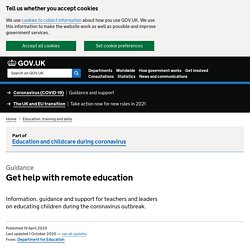
Remote education support: available now The items in this section are available now. Devices, internet access and digital education platforms. Local Lockdown Lookup - Matthew Somerville. This postcode lookup uses MapIt(an API to provide postcode to council lookup, take a look) to look up the council and ward for your postcode, and then tells you if there are currently any nationally-imposed local restrictions.
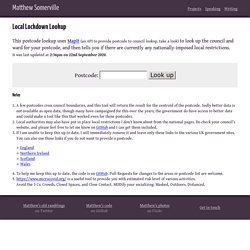
It was last updated at 2:36pm on 22nd September 2020. Notes A few postcodes cross council boundaries, and this tool will return the result for the centroid of the postcode. Sadly better data is not available as open data, though many have campaigned for this over the years; the government do have access to better data and could make a tool like this that worked even for those postcodes. Local authorities may also have put in place local restrictions I don’t know about from the national pages. Mental wellbeing. They collect information about how you use our website.

This helps us make the website better. None of these cookies are used to tell us who you are. If you continue to use this website without changing your preferences, we will consider that you agree to the use of cookies. We use cookies for the following reasons: Site preferences These types of cookies measure how you use the website, like where you click. Website usage These types of cookies measure how you use the website, like where you click, so it can be updated and improved based on your needs. Health campaigns We run health awareness campaigns with trusted partners. Find out more about cookies and see our detailed list of cookies by clicking on the cookie declaration link in the footer. Higher education: reopening buildings and campuses. Introduction This guidance applies nationally, but you should follow local public health guidance if restrictions are in place in your area.
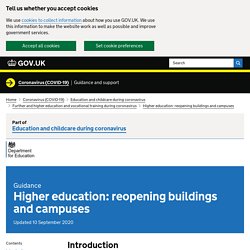
This guidance builds on the existing guidance for reopening higher education (HE) campuses, and may be updated further in line with developing scientific evidence. The latest update includes: further advice on reopening university buildings guidance on the importance of good ventilation guidance on when and where face coverings may be required updates on social gatherings relevant to higher education additional advice on the performing arts additional advice on student accommodation advice on local outbreaks, including student movement advice on NHS Test and Trace The higher education (HE) system in the United Kingdom has a world class reputation.
How schools can plan for tier 2 local restrictions. COVID-19 contain framework: a guide for local decision-makers. 16 to 19 funding: 16 to 19 tuition fund. Purpose The purpose of this guidance is to set out the expectations for and conditions under which the Education and Skills Funding Agency (ESFA) will support students via the 16 to 19 tuition fund in 2020 to 2021.
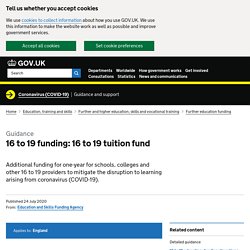
Providers should also have regard to the needs of students with special educational needs and disabilities (SEND), particularly where they have experienced additional disruption to learning as a result of their specific needs and disabilities. Coronavirus (COVID-19) related deaths by occupation, England and Wales. When trying to understand rates of coronavirus (COVID-19)-related deaths by occupation, it is likely that there will be many complex factors.
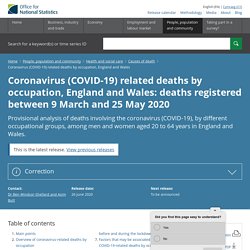
In this section, we provide information on a range of factors that may be associated with the deaths described in this bulletin. A recent report from Public Health England describes a wide range of factors associated with COVID-19 more generally. Some occupations are more likely to be exposed to the virus than others Analysis on the occupations with the highest potential exposure to the coronavirus (COVID-19) shows that jobs involving close proximity with others, and those where there is regular exposure to disease, are most likely to be exposed to COVID-19.
Examples include health care workers, though during the pandemic some of these are more likely to be using personal protective equipment (PPE). Distancing in schools - Education in the media. While it remains the case that people should maintain a two metre gap between themselves and others in public places, the department has always made clear that we know this is not always going to be possible for younger children.
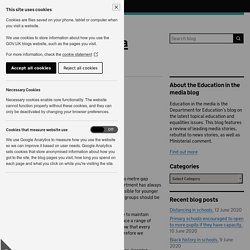
Public Health England reports that while general groups should be kept apart, brief contact among children remains low risk. It is important to reiterate that while effort should be made to maintain distancing between pupils, the key is for schools to introduce a range of protective measures to safeguard their pupils. We also know that every school is different and circumstances will vary in each, therefore we understand that flexibility is needed. By introducing measures such as reducing the size of classes, keeping children in small groups and frequently cleaning classrooms, schools can ensure they minimise risk. Coronavirus (COVID-19) - guidance for providers and students - Office for Students. Coronavirus (COVID-19) roundup. Office for National Statistics (ONS) data and analysis are vital for informing the public and the government’s response to COVID-19.
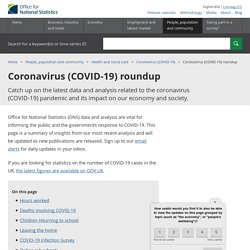
This page is a summary of insights from our most recent analysis and will be updated as new publications are released. Sign up to our email alerts for daily updates in your inbox. If you are looking for statistics on the number of COVID-19 cases in the UK, the latest figures are available on GOV.UK. This page was last updated at 09:30 on 3 June 2020. 3 June 2020 Hours worked Analysis of the latest UK labour market statistics looks at which industries and workers have been most affected by the fall in total weekly hours worked, between January to March 2019 and January to March 2020. There has been a reduction in average hours worked across all industries, and it is the accommodation and food services industry which has seen the largest loss, at 11.5%. Schools reopening Q&A - Education in the media.
Yesterday, Monday 11 May, the Department for Education published guidance on the wider opening of nurseries, schools and colleges.
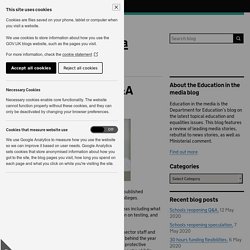
These guidance documents provide detail on a range of areas including what settings can do to help make sure they are safe, information on testing, and details for alternative provision and special schools. There are a number of key issues which we know parents, sector staff and the media will be interested in. These include the rationale behind the year groups that will return in the first phase, guidance on what protective measures should be in place, and whether or not attendance at a child’s education setting will be compulsory. These issues are addressed below. Why are certain year groups going back in the first phase? The rate of infection remains too high to allow the full opening of schools for all pupils yet. There are three key reasons why nurseries, Reception, Year 1, Year 6, Year 10 and Year 12 are being prioritised.
The time is ripe to reform UK university finance. Alastair Campbell: We are witnessing a national catastrophe. Using a virtual learning environment - Case study. Over several years, our schools have been investing in technology in the classroom to support our teachers and pupils.
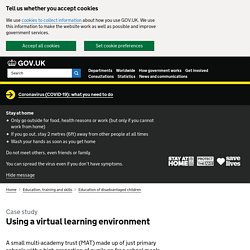
Before school closures, pupils accessed their class work via a OneNote notebook (online software that acts like a notebook) for their year group. As the virtual school became a reality, we have supported our families by offering: